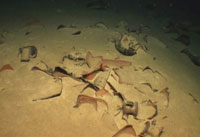
Broken pottery from Roman wreck Photo: Greek Culture Ministry
Two Roman-era shipwrecks have been found in water slightly less than a mile deep off the western Greek islands of Corfu and Paxoi. The two third-century wrecks were discovered earlier this month during a survey of an area where a Greek-Italian gas pipeline is to be sunk.
It has long been supposed that most ancient sailors preferred coastal routes over sailing in deep water. The depth of these wreck raise questions about that theory. Most shipwrecks from the era have been found in shallow waters closer to the coast. It may be that the protection provided by inshore sailing were cancelled out by the likelihood of striking coastal reefs or being blown ashore. Then again, deep-water wrecks can also be harder to locate than shallower water wrecks. It is also possible that the Roman ships were blown into deep water before sinking.
Shipwreck findings challenge conventional theory
Most scholars believe that ancient traders were unwilling to veer far offshore, unlike warships which were unburdened by ballast and cargo.
“There are many Roman shipwrecks, but these are in deep waters. They were not sailing close to the coast,” Simossi said.
“The conventional theory was that, as these were small vessels up to 25 meters long, they did not have the capacity to navigate far from the coast, so that if there was a wreck they would be close enough to the coast to save the crew,” she said.
US archaeologist Brendan Foley, who was not involved in the project, said a series of ancient wrecks located far from land over the past 15 years has forced experts to reconsider the coast-hugging theory.
“The Ministry of Culture’s latest discoveries are crucial hard data showing the actual patterns of ancient seafaring and commerce,” said Foley, a deep water archaeology expert at the Woods Hole Oceanographic Institution in Massachusetts.
Jeffrey Royal, director of the Key West, Florida, based RPM Nautical Foundation, said that in many cases – as when winds threatened to push ships onto rocks – ancient mariners made a conscious effort to avoid coastal waters.
Royal, whose foundation has carried out a series of Mediterranean underwater projects, said the depth of such finds is immaterial from an archaeological standpoint.
“In antiquity ships didn’t sail around with depth finders and keep track of how deep they were,” he said. “It was more how far they were on the surface in relation to land. After 30 meters of depth the boat’s safe, so if it’s 30 meters or 3,00 meters it’s a little irrelevant.”
The remains were located during an investigation that covered 200 square kilometres of seabed off the islands of Corfu and Paxoi.
Thanks to Alaric Bond, Phil Leon and Cynthia Drew for contributing to this post.
